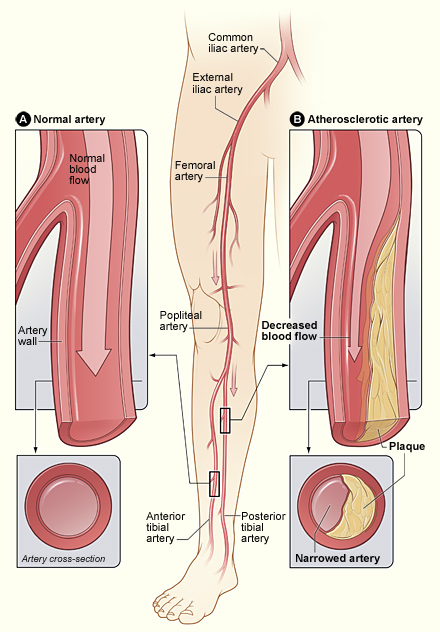What Is Peripheral Arterial Disease?
Peripheral arterial disease (P.A.D.) occurs when
plaque (plak) builds up in the arteries that carry blood to your head, organs,
and limbs. Plaque is made up of fat, cholesterol, calcium, fibrous tissue, and
other substances in the blood.
When plaque builds up in arteries, the condition is
called
atherosclerosis
(ATH-er-o-skler-O-sis). Over time, plaque can harden and narrow the arteries.
This limits the flow of oxygen-rich blood to your organs and other parts of
your body.
P.A.D. usually affects the legs, but also can affect
the arteries that carry blood from your heart to your head, arms, kidneys, and
stomach. This article focuses on P.A.D. that affects blood flow to the
legs.
Normal Artery and Artery With Plaque
Buildup

The illustration shows how P.A.D.
can affect arteries in the legs. Figure A shows a normal artery with normal
blood flow. The inset image shows a cross-section of the normal artery. Figure
B shows an artery with plaque buildup that’s partially blocking blood
flow. The inset image shows a cross-section of the narrowed artery.
Overview
Blocked blood flow to your legs can cause pain and
numbness. It also can raise your risk of getting an infection in the affected
limbs. It may be hard for your body to fight the infection.
If severe enough, blocked blood flow can cause
tissue death (gangrene). In very serious cases, this can lead to leg
amputation.
If you have leg pain when you walk or climb stairs,
talk to your doctor. Sometimes older people think that leg pain is just a
symptom of aging. However, the cause for the pain could be P.A.D. Tell your
doctor if you're feeling pain in your legs and discuss whether you should be
tested for P.A.D.
Smoking is the main risk factor for P.A.D. If you
smoke or have a history of smoking, your risk for P.A.D. increases four times.
Other factors, such as age and having certain diseases or conditions, also
increase your risk.
Outlook
If you have P.A.D., your risk for
coronary
artery disease,
heart
attack,
stroke, and
transient ischemic attack (“mini-stroke”) is six
to seven times greater than the risk for people who don’t have P.A.D. If
you have heart disease, you have a 1 in 3 chance of having blocked leg
arteries.
Although P.A.D. is serious, it’s treatable. If
you have the disease, it’s important to see your doctor regularly and
treat the underlying atherosclerosis.
P.A.D. treatment may slow or stop disease progress
and reduce the risk of complications. Treatments include lifestyle changes,
medicines, and surgery or procedures. Researchers continue to explore new
therapies for P.A.D.
September 2008
|

